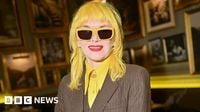Scottish fashion designer Pam Hogg, a trailblazer whose bold vision dressed some of the world’s most iconic celebrities and upended the conventions of British fashion, has died in London following an undisclosed illness. Her family announced her passing on Wednesday, November 26, 2025, through a heartfelt statement on her Instagram account, expressing deep sadness and gratitude for the care she received at St. Joseph’s Hospice in Hackney during her final days. Hogg, who was believed to be in her 60s but never publicly revealed her age, spent her last hours surrounded by the loving presence of cherished friends and family.
“A glorious life lived and loved,” her family wrote. “Pamela’s creative spirit and body of work touched the lives of many people of all ages and she leaves a magnificent legacy that will continue to inspire, bring joy and challenge us to live beyond the confines of convention.” The family also extended their thanks to the hospice staff for their “beautiful support.”
Hogg’s influence on fashion is hard to overstate. Born in Paisley, Scotland, she studied Fine Art and Printed Textiles at the Glasgow School of Art before heading to the Royal College of Art in London. It was in the creative ferment of 1980s London that she made her mark, launching her first collection, Psychadelic Jungle, in 1981—a line inspired by the strict dress code and electric atmosphere of the legendary Blitz Club. According to BBC News, Hogg once said, “I started making clothes when I was about five years old from all the hand-me-downs from neighbours… I was really formulating my look way back then.”
Her designs, which veered from the futuristic to the punk-inflected, quickly became synonymous with the edgy, rebellious spirit of the era. Hogg’s signature piece—the catsuit—became a staple not just in her own wardrobe but in those of the world’s biggest stars. Her creations were worn by the likes of Debbie Harry, Kate Moss, Rihanna, Lady Gaga, Kylie Minogue, Beyoncé, Naomi Campbell, Björk, Grace Jones, Kelly Rowland, Princess Diana, Princess Eugenie, and even Taylor Swift. As The Independent noted, Minogue’s black mesh metal-studded catsuit in the 2007 “2 Hearts” music video was one of Hogg’s most memorable designs.
Hogg’s influence extended beyond fashion runways. She staged her first catwalk show in 1985 and soon after opened a boutique in Soho, London, before launching her first standalone shop on Newburgh Street in 1989. Her early designs, as described on her website and reported by WWD, “grabbed clubland by the scruff of its neck” and were stocked by Harrods, Harvey Nichols, and Bloomingdale’s. She was a regular presence at the Blitz Club and was considered a cult figure alongside other icons of the era.
Music was a constant thread in Hogg’s life. Her first band, Rubbish, opened for The Pogues, and she later supported Debbie Harry of Blondie. She toured with the industrial band Pigface and founded the band Doll, which opened for The Raincoats. She even took a creative detour to make the fashion film “Accelerator,” starring Primal Scream’s Bobby Gillespie. Hogg’s artistic reach extended to theater as well: in the 2010s, she was commissioned to design costumes for a production of “Cyrano de Bergerac” by the National Theatre of Scotland, the Citizens Theatre, and the Lyceum.
Her runway shows were legendary for their energy and inclusivity. In her 2009 return to fashion, Hogg enlisted models such as Alice Dellal, Daisy Lowe, Jaime Winstone, and Liberty Ross. Vivienne Westwood was among the luminaries who attended her first Paris show in 2012. In recent collections, Hogg worked with shiny PVC, delicate tulle, and leather, creating catsuits and dresses that balanced provocation with elegance. According to designer Daniel Lismore, Hogg “cast models who reflected the world and she pushed ideas that others were too timid to touch. She walked into every room with courage that shook the walls.”
Hogg’s activism and commitment to human rights were as much a part of her legacy as her fashion. Lismore described her as “an activist at heart,” saying, “She stood for human rights long before it was safe to do so and she proved that fashion can hold a conscience and still make history.”
Her creative genius was recognized in 2016 when she was chosen to design the statuettes for the Brit Awards, producing 13 trophies characterized by her signature use of glitter and metallic tones. “I adored her catsuit,” Lismore told WWD. “It will live forever and in the history books there will be a picture of Pam beside it.”
Tributes poured in from across the arts and fashion worlds. Broadcaster Fearne Cotton wrote, “Pam. Oh Pam. What a joy it was to know you. I’ll miss you Pam.” Menswear designer Kim Jones called her “our warrior queen,” while designer Bella Freud lamented, “How sad to think of the fashion world without her shining brilliance.” Garbage singer Shirley Manson described Hogg as “the Iconoclastic and fantastic Dr Hogg,” adding, “The brilliance and the bravery and the extraordinary, explosive sense of humour that perpetually burled you forth with tremendous force. Dr Hogg may have left the runway but you will be found in the long and storied history of British fashion and in the imaginative, pioneering work of each and every fashion designer who trails in your wake.”
Hogg’s personal style—lemon-yellow hair, bold sunglasses, and slogan T-shirts—was as distinctive as her collections. Her Instagram account, with 152,000 followers, showcased not only her work but also her mischievous sense of humor and commitment to living outside the norm. As her family wrote, “Pamela will continue to live in our hearts and minds.”
Though she is gone, Pam Hogg’s impact on fashion, music, and the broader cultural landscape will continue to reverberate for generations. Her legacy is one of fearless creativity, inclusivity, and the joy of challenging convention—a legacy that will inspire artists and dreamers for years to come.


